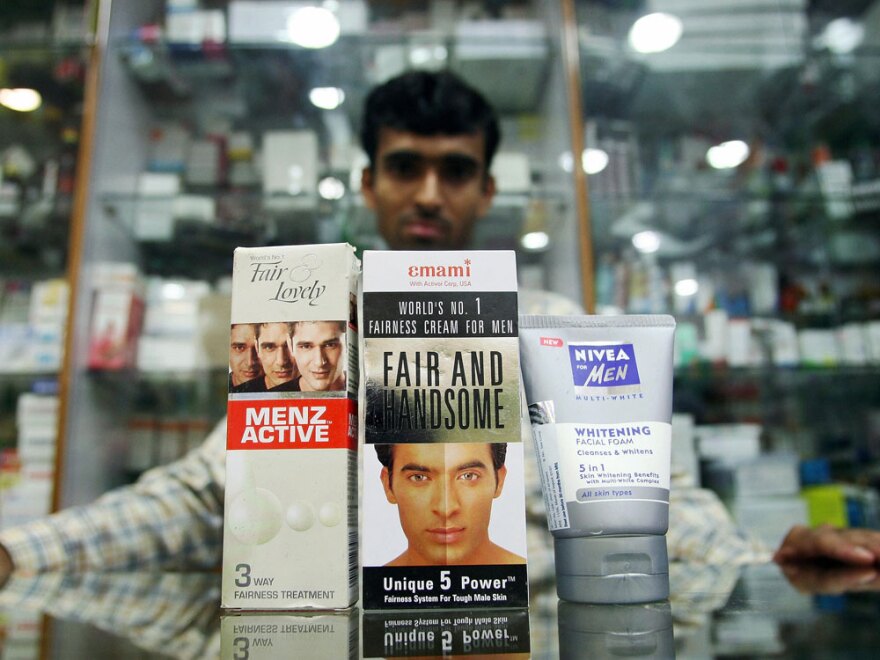Truth matters. Community matters. Your support makes both possible. LAist is one of the few places where news remains independent and free from political and corporate influence. Stand up for truth and for LAist. Make your year-end tax-deductible gift now.
In India, Skin-Whitening Creams Reflect Old Biases

For decades, the cosmetics industry in India has made millions selling skin-whitening products to women. Now, it's making more money by convincing Indian men that they should be lighter.
Industry analysts say skin-lightening creams for men, first introduced a few years back, are selling well, and that the Indian market is growing as India's economy improves.
The TV advertisements tend to send the same message: Light skin makes you attractive to women and successful at work. Dark skin, by implication, does not.
'White Is Hot'
"Obviously what you don't have is what you want. The Western world, they go in for tans. They want to get a little brown touch to themselves. They think that's hot," says Darshan Gokani, 27, a model for TV and print commercials. "So, what we think over here, since we are brown-skinned people, white is hot."
Gokani, who works in Mumbai, capital of India's entertainment industry, says modeling is a tough business.
"Oh, my God, it's really, really competitive," he says. "I got in easily, but even if I go for an audition now, the audition goes on for three days, and there are at least 500 boys coming in for an audition each day."
Gokani says he is lucky to be, as he puts it, "nice and fair." He also has naturally curly hair. He says advertisers like his "look" because it is unusual. But Gokani says he believes most of the young Indian men who show up for those auditions are using skin-lightening creams.
"Out of 500, I think at least 300 of them, definitely," he says. "Earlier, it was all hidden. But now it's all open. They want to be fair; they want to be nice. Anyone who's fair gets on Indian television."
N. Radhakrishnan, founding editor of Man's World — one of a half-dozen men's lifestyle magazines that have cropped up in India in recent years targeting the country's new class of affluent fashion-conscious males — says that in India, skin color is an issue from birth.
"Well, Indians like white skin, that's it," he says.
He adds: "Indian women also want their kids to be, you know, fair-skinned. That's one of the first things that they ask: Is he fair-skinned? And it's right across, it cuts across the country."
Reinforcing Stereotypes
Cosmetics manufacturers claim their skin-whitening creams produce results within weeks or even days, though there are many skeptics. The creams generally contain sunscreen and moisturizer, plus a formula that the companies claim affects skin's melanin, which determines its color.
This is a sensitive subject in India. The cosmetics industry and its ads have been accused of reinforcing stereotypes about race, caste and gender.
"We believe that beauty is beyond color, and that every woman or child born, male or female, has the right to believe that they are of value," says Kavitha Emmanuel of the women's rights group Women of Worth.
Emmanuel says some Indian women are so concerned about pigmentation that during pregnancy they will eat saffron and powdered gold in the belief that this will make their babies lighter.
The scale of the pressure on Indian women to have paler skin can be seen in the matrimonial columns of India's newspapers. Advertisements, taken out by parents seeking brides for their sons, frequently specify that they are seeking "fair" or "very fair-skinnned" girls.
Roots Of Desire
The desire for pale skin has roots that run deep in India's history. It's entwined with Hinduism's complex social hierarchy, or caste system. Those higher up the scale generally tend to have paler skins than people on the bottom rung.
Meenakshi Reddy Madhavan, a young writer who blogs about Mumbai's social scene, says that's one reason some Indians seek to become whiter.
"It indicates to someone who's meeting you for the first time that you are born into a family where you haven't had to do any outdoor work, and that your status is higher because you never had to be in the fields or do any of that," Madhavan says.
Madhavan says the prejudice in favor of lighter skin is stronger among India's older generations. Those skin-whitening ads aimed at young people don't seem to have worked on her.
"I like being brown! It's nice that I can wear a lot of clothes that contrast with my skin color, and I have lots of fun with the brownness," she says. "In fact, I go out of my way to get even browner."
Prahlad Kakkar, a well-known director of television ads in Mumbai and a social commentator, says some Indian men have been using indigenous natural remedies to lighten themselves for centuries. He has an unusual theory about why: He says throughout history, India has repeatedly been invaded. These invaders — Persians, Moghuls, the British — tended to have lighter skin than Indians, so paler skin has become associated with power.
"It's something that is a part of the legacy and the burden that the dark man has to bear for the pillaging and the raping and the conquering of the white man," Kakkar says.
Kakkar, who is nearly 60 and has a successful career behind him, has a word of advice for young Indian men who hope having paler skin will put them on the road to social or sexual conquest.
"It's always a waste of time to try to look different from what you are," he says. "What are the most attractive things about a man? When he's younger, it's his belief in himself and his articulation, and his imagination. And when he's older: his bank balance!"
Copyright 2022 NPR. To see more, visit https://www.npr.org. 9(MDA1OTI3MjQ5MDEyODUwMTE2MzM1YzNmZA004))







